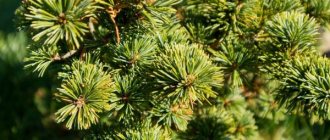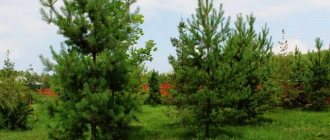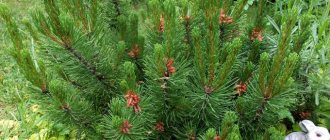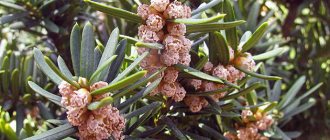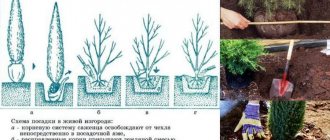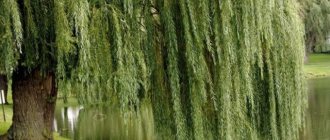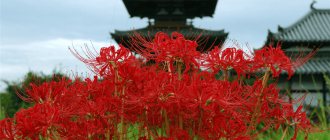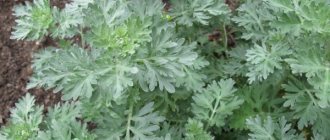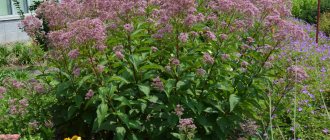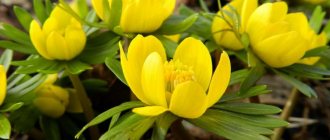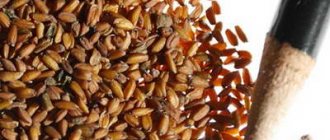Description of the plant
Mountain pine is an evergreen multi-stemmed shrub that reaches up to 5 meters in height. The shoots of the plant are short, spreading, and slightly curved upward. The highly branched root system is located superficially, and this must be taken into account when loosening the soil. Coniferous needles are small, 4-6 cm in length, painted in a dark olive color. Cones begin to form from the age of six.
Dwarf pine is indispensable in landscape design. Has a number of advantages:
- frost resistance and drought resistance;
- thanks to its strong rhizome, it withstands gusty winds;
- pine is unpretentious to the composition of the soil;
- responds well to crown formation;
- has strong immunity to diseases;
- with good care, life expectancy is up to 1000 years.
Care
The most important period for a young mountain pine plant is the first month after planting, during which the seedling should take root. Watering at this time should be done twice a week along the outer diameter of the planting hole.
In the first few years, pine may also suffer from winter and early spring sunburn. To prevent this from happening, you should cover the delicate branches with spruce branches, burlap or spunbond.
Under a thick layer of snow, which often snows in certain regions of Russia, the branches of mountain pine do not break. However, after the snow has melted, it is best to carry out the first watering not with cold, but with warm water, capturing not only the root, but also the coniferous crown.
Young plants require regular watering during dry summers and autumns, as well as periodic application of fertilizer intended for coniferous trees.
Adult representatives of mountain pine tolerate both drought and frost well, so they do not need to be watered abundantly and sheltered from the winter sun.
Important nuance! Under no circumstances should pine needles that fall toward the roots be removed, as they create a litter that protects the pine tree from moisture loss and contributes to additional replenishment of organic elements.
Over the course of a year, the average growth of a pine tree is 10-15 cm in height and width, and the maximum height and diameter of the crown depends on the specific variety of pine.
Selection of variety and seedlings
Dwarf . The shrub is low growing, growing up to 1.5 meters in height. It has a ball-shaped crown formed from dark olive needles. Looks ideal both in single and joint plantings on lawns and rocky gardens.
Mini Pug . The plant of this species has a cushion shape with dark green needle-like needles. The pine is dwarf, reaching a height of up to 60 cm. It grows well in partial shade and is an indispensable addition when designing rocky gardens.
Columnaris . Tall variety of mountain pine. An adult plant reaches up to 3 meters in height. The crown is narrow-conical, up to 3 meters in diameter.
Winter Gold . The pine is small, up to half a meter in height and a meter in diameter, and forms a dense spherical crown. The variety has the ability to change the color of its needles: in summer - light olive, in winter - bright golden.
Cockade . An exotic variety that has yellow stripes on the needles, reminiscent of dragon eyes.
Ophir . Popular due to the shape of the crown, reminiscent of a pin. If the plant is grown in a lighted place, the color of the needles will be light yellow; in the shade, the needles will become dark green.
It is necessary to select only healthy seedlings for planting. A healthy plant is brightly colored; the tips of the needles should not be dried out or yellowed. For better survival, shrubs must be purchased with a closed root system.
For planting, purchase a young plant, the age of which should not exceed five years.
It is better to purchase seedlings from trusted suppliers, greenhouses or nurseries, as this increases the chance of purchasing a healthy plant tenfold.
Planting Crimean pine. Choosing a seedling or its alternative
It would seem that planting a pine tree cannot cause any complications. I dug myself a tree, brought it from the forest, and planted it. But pines are only seemingly harsh and hardened trees.
Few people know that young pine roots die after being outdoors for more than 15 minutes.
Therefore, the best option is to buy a pine or spruce seedling from a special nursery. There is a wide selection of species that have both high aesthetics and beneficial properties.
The main types of coniferous seedlings offered in stores are:
- Scots pine,
- Crimean, cedar,
- mountain (black) pine,
- Weymouth pine,
- Mugus pine.
Let's consider the main types of pine trees suitable for planting on the site near the house:
Scots pine
Scots pine is the most familiar to our eyes. Its most important advantages are rapid growth and minimal maintenance. Planting Scots pine near your house or in your country house will require a little effort on your part, but after 3-4 years you will have a magnificent tree. Scots pine will be very useful if you have ravines or steep slopes on your site. It has a kind of root system that holds the earth. Scots pine is available in all nurseries.
Crimean pine
Another name for Crimean pine is Pallas pine. This is an endemic of Crimea, therefore the plantings of Crimean pine are only of artificial origin. As for the height of the Crimean pine, it reaches 40 m (in open areas). The main useful quality of Crimean pine in landscape design is its unpretentiousness in relation to the soil. The environmental sustainability of Crimean pine in the city is also well known (in this way it is close to black).
Crimean pine
mountain pine
Mountain pine (synonym: black) is a multi-stemmed tree. Black pine has many varieties and clones.
Most varieties of mountain pine are dwarf trees; there are groundcover varieties, while the original species grows up to 25 meters.
The advantage of mountain pine, compared to Crimean pine, is its strong branching. Black pine is light-loving. It is not picky about soils, but, nevertheless, mountain pine grows best on limestone soils. Mountain pine is also characterized by its unpretentiousness to soil moisture - it can tolerate both drought and temporary excessive humidity.
Weymouth Pine
Weymouth pine is also called eastern white pine. Weymouth pine grows well in acidic soils. Imported from North America. In the wild, it grows only in mixed forests. Weymouth pine has several varieties that have a beautiful cone-shaped crown.
Like all pine trees, it is resistant to frost, but young trees still need more careful care - in the fall their roots should be covered with burlap. This is more protection from sunlight than from frost, since Weymouth pine is sensitive to light at an early age.
Weymouth pine is also characterized by high resistance to disease. But Weymouth pine (unlike black or common) is very selective regarding the humidity of the site - it does not tolerate either excessive moisture or drought.
Weymouth Pine
Cedar pine
The pine pine is a whole group of species that includes evergreen trees with edible cones - pine nuts. When choosing cedar pine, we recommend planting European pine on the site.
This tree grows up to 25 meters (while the height of the Siberian cedar pine is up to 40 m). Cedar pine in cultivated plantings goes well with deciduous tree varieties.
You can also plant a variety of cedar pine called dwarf cedar. This is a low bushy plant. It will look good on the sides of alleys.
Mugus pine
Mugus pine is a variation of the mountain pine, which has the shape of a spherical shrub. Mugus pine grows up to 3 meters in height and is a fairly unpretentious tree. Distribution: forests. Mugus pine is not picky about the type of soil (it can grow in both acidic and alkaline soils), so it is one of the species that is also easy to grow from seeds. The only requirement, as with all conifers, is good soil drainage. Also, Mugus pine is frost-resistant and, most importantly, resistant to urban conditions (unlike Weymouth pine).
Mugus pine
An alternative to seedlings is propagation by seeds. Most types of pine can be grown from seeds at home. To do this you will need:
- several cones of the desired type (for obtaining seeds),
- containers for growing
- and a little perseverance, patience and time to care for the seedlings.
As for spruce trees, the nursery offers the following types of spruce: common, prickly, Serbian and Canadian with their subspecies and varieties.
All spruces are equally whimsical when transplanting - they are afraid of drying out and heavily shaded areas of the forest.
Planting a mountain pine
The growth and development of the plant depends on the choice of location and soil preparation. A properly prepared site is the key to successful growth.
Place, soil, scheme and timing
Dwarf pine is a light-loving plant and grows on almost any soil. Therefore, you need to choose a well-lit place. The soil should be low acidity. To obtain a decorative appearance, it is better to plant pine on sandy or sandy loam soil. If the soil contains a lot of sand, it must be diluted with clay.
The best time to plant mountain pine is considered to be early spring (April-May) or autumn (early September).
Before planting a mountain pine, it is necessary to properly prepare the hole. To do this, dig a hole a meter deep and line the bottom with compost, manure or nitrogenous fertilizers. Seedlings with a lump of earth are carefully placed in a prepared place and covered with earth, making sure that the root collar remains above the surface of the earth. The soil is thoroughly compacted, watered and mulched.
If more than one plant is planted, they must be placed at a distance of 2 meters from each other.
Caring for young seedlings consists of sheltering them from the sun and timely watering as the top layer of soil dries out, for 2-3 weeks. A young plant tolerates replanting much better and takes root faster, therefore, for this you need to purchase five-year-old seedlings.
Landing
Conifers do not tolerate transplantation well. For this reason, it is best to purchase plants grown in containers or dug up with a clod of soil and well packaged.
Planting mountain pine in the garden (photo)
The best time for planting coniferous plants with an open root system is the second half of April. Container conifers can be planted throughout the season, provided that the seedlings are properly watered and shaded.
Unlike most conifers, which require an acidic soil reaction, alkaline soils are preferred for mountain pine. Sandy ones that freely allow water to pass through are ideal for this type of pine, which is accustomed in natural conditions to poor, rocky soils.
When planting the species Pinus montana or its decorative forms, perform the following operations:
- select and mark a place for planting;
- dig a hole measuring 0.8 x 0.8 x 0.8 meters and loosen the bottom;
- Apply mature organic fertilizers or compost in a 20 cm layer and mix with loosened soil;
- carefully remove the plant with a lump of earth from the bag or plastic container, trying not to damage the roots;
- place it in a hole at the same depth at which it was previously in the nursery or container, adding garden soil if necessary;
- fill the hole with earth and compact it;
- An earthen edge is formed around the seedling and watered well.
When planting, it is important not to bury the seedlings: the root collar should be at soil level. It is permissible to bury only those seedlings that were obtained by cuttings. It is advisable to mulch the tree trunk circle with crushed pine bark, gravel, and peat chips. Mulch protects the soil from drying out and weeds.
A planted pine requires supervision at first, while it takes root and its root system strengthens. You need to ensure that the soil is loose and does not dry out. It is advisable to shade a fragile seedling from the scorching rays of the sun. The shading structure is placed on the south side of the plant.
Mountain pine care
Mountain pine is an unpretentious plant. For growth and development, it needs to create favorable conditions.
Watering and fertilizing. Dwarf pine is drought-resistant and does not require additional watering. The exception is the Rumelian pine variety. This variety is moisture-loving and requires watering three times a season in the amount of two buckets per plant.
Feeding is applied to young shrubs in the first two years of growth. Rules for feeding and fertilizing:
- nitrogen fertilizers are applied to the planting hole;
- In spring, only complex fertilizers are used;
- in the autumn, the plant cannot be fertilized, since the young plant will not survive wintering well;
- After two years, the plant does not need to be fertilized, since it will receive the nutrients that accumulate in the coniferous litter.
Pruning and shelter for the winter . Most pine varieties form their crown on their own, and therefore do not need additional pruning. Pruning is carried out only to prevent the disease, removing old, frozen and damaged branches.
To create a lush crown in the spring, carefully pinch off young shoots by ⅓. Thus, the crown of the bush will become much thicker, and the branches will slow down their growth.
Dwarf pine can withstand severe frosts, but to preserve young seedlings it is better to cover them. This procedure is done in order to protect the plant from sunburn. Spruce branches or special breathable covers are ideal for this purpose.
Planting conifers in late autumn. Rules for planting coniferous plants
Still, early autumn is the most preferable time for landscaping
Seedlings with a clod of earth
plot by representatives of coniferous species. It is at this time that it is recommended to plant conifers in containers or with a ball of earth. As long as the soil is warm enough and the air is no longer hot, the seedlings take root best. They immediately begin to grow new roots, which helps young plants better survive the winter and begin to grow actively in the spring.
Planting conifers with exposed root systems often gives negative results. For example, a tree dug up in the forest does not want to grow in an area where they are trying to create all the necessary conditions for it. The secret lies in the fact that when coniferous plants have taken root and grown in a certain place (in a nursery, in a forest), the fungus mycorrhiza, which is vital for the plant’s existence, settles on their roots. A pine or spruce, dug up and cleared of root soil, loses its symbiosis partner.
Planting conifers
- Many coniferous plants do not tolerate stagnant water in the root zone. Therefore, on clayey and heavy soil in the planting hole, it is necessary to make drainage from bricks and sand.
- The root collar of the plant should not be buried when planting.
- After watering, it is useful to mulch the tree trunk circle with pine litter.
- Since coniferous trees do not bare their crown for the winter, their need for fertilizing is not high compared to deciduous trees. But it is very useful to water the tree trunk circle with root growth stimulants a week after planting.
- Conifers planted in autumn should be protected from frost and sunburn. In winter, the root system is dormant and moisture does not reach the branches and needles. However, the winds and winter sun mercilessly dry out the needles. Plantings should be covered with agrofibre, reed mats or spruce branches.
- If the winter is snowy with frequent thaws, you will have to deal with the damping off of the lower branches under the wet snow. Plantings should be regularly inspected and wet snow should be shaken off to prevent fungal diseases from developing on the branches.
Beneficial mycorrhiza on the roots
It is advisable to strengthen newly planted trees by tying them to a wooden stake. This is done so that strong gusts of autumn winds do not rock the seedlings, undermine young roots, or injure them. Abundant watering at the rate of 20 liters per square meter is another necessary condition for the successful establishment of young conifers.
Reproduction and growth
Pine is propagated by seeds, cuttings and grafting. The simplest method is considered to be propagation by seeds. Reproduction by cuttings and grafting is considered an insufficiently effective method and can only be done by specialists.
Seed method
When propagated by seed, the shrub completely retains its decorative properties. This method is simple, and even novice gardeners can handle it. Seed propagation process:
- If seeds are sown at home, they must undergo stratification for 1.5–3 months. Seeds planted in open ground do not need stratification.
- Planting is carried out in spring in prepared seedling boxes.
- The substrate is light, nutritious and disinfected, sprinkled with peat on top to prevent fungal diseases.
- Stratified seeds are disinfected and planted in prepared soil at a distance of 5 cm from each other.
- The container is covered with polyethylene to create a favorable microclimate.
- After the shoots emerge, this takes about a month, the covering material is removed, and the container is moved to a warm, lighted place.
- Caring for seedlings involves timely watering.
- Plant strengthened seedlings in open ground a year after rooting. The best time for planting is early spring.
Choosing pine for the site
If you decide to plant a conifer at your summer cottage and don’t know where to start, then among the recommendations on how to plant a mountain pine correctly, the first priority will be advice on selecting a variety suitable for the garden and choosing a seedling when purchasing.
Variety selection
Mountain pine has several subspecies and decorative varieties, but we will now describe only some of the most interesting of them.
Subspecies include: trees, multi-stemmed and elfin shrubs.
In gardens, the most common are shrub (mugus) and dwarf (pumilio) forms. Both the first and second have many varieties. These are mainly dwarf and ground cover shrubs. They have different crown shapes (spherical, cushion-shaped, columnar, etc.), height (from 40 cm to 4 m), and needle color (bright green, dark green, bluish, golden).
Diseases and pests
Coniferous plants have strong immunity to many diseases . But there are cases when the disease affects young, immature seedlings. This happens from improper care, after winter or after a rainy summer.
Schutte . Fungal disease. Recognizing the disease is not difficult: the needles turn dark red with black dots, the branches dry out, and a thin cobweb appears on the plant. Treatment consists of treating the plant with Bordeaux mixture and removing damaged branches. For prevention, the bush is treated with a copper-containing solution or horn.
Scleroderriosis . A common disease that affects coniferous plants. As a result of the disease, first the apical buds begin to die, and then all the branches. The spread of the disease can only be prevented by timely removal of the affected branches.
Aphid . Mountain pine is often affected by aphids. To combat it, chemical and biological products are used.
Planting coniferous plants and caring for them is not a very labor-intensive task and does not take much time. This shrub fits harmoniously into any corner of the garden: it decorates alpine hills, rocky gardens, and thanks to its shallow root system it is able to strengthen the slopes of reservoirs.
Selection of planting material and time for transplantation
Gardeners recommend taking seedlings with closed roots from a nursery. The shoot must be at least 3 years old. Such a tree will 100% take root on a personal plot. Mountain pine, a low-growing plant with a beautiful crown, is popular. It is used in creating landscape design.
To save money, you can dig up a tree in a pine forest yourself. The main thing is to carefully remove the sprout from the ground, leaving a large lump of soil so as not to expose the roots. You cannot dig up a young seedling growing on a slope, the root system of which is exposed and the trunk is bent. The plant does not take root well and looks ugly.
The optimal season for replanting coniferous crops is autumn. This is usually September, when it is quite warm and humid. During this period, it is safe to remove the root system from soft soil. Sometimes seedlings are transplanted in April or May, depending on the weather. The main thing is that there are no frosts in the spring; fragile roots are afraid of low temperatures.
The tree is dug up carefully, gradually exposing and removing the roots from the soil. It is important not to cause damage to the root system. It is recommended to use young seedlings. They are easy to transport if the site is far from the forest.
Selection and preparation of seedlings
Pine from the forest must be carefully checked before digging. Externally healthy plant specimens may turn out to be brittle, and this is a minus. If such trees are transplanted, they will not grow and will quickly dry out.
It is strictly necessary to dig out the lump together with the tree, otherwise the roots without the lump will die within half an hour. The lump with the root system must be wrapped with thick cloth to avoid lumps falling apart.
Understanding how to replant a pine tree without pieces falling apart is very important, and the main task is to drive the shovel deep into the soil and maintain the shape of the ball. The collapsed pieces of earth will be of no use, and it will not be possible to replant the trees. The fabric should be damp. It is slipped under the lump during the digging process and thus the tree is removed from the bottom.
Mountain pine: an unpretentious guest from the peaks
If you start talking about decorative conifers, you inevitably come to pine. Why not? The name is familiar to everyone, the appearance is familiar to everyone. And not everyone realizes that there are many varieties of pine trees. And that the classic giants with rusty-brown trunks planted on the sandy terraces of our rivers are by no means a dogma. Mountain pine is a typical exception to the rule. An unusual elastic dwarf tree, characteristic of very special habitats in nature, can easily settle near your house!
Mountain pine (Pinus mugo) - also known as zherep. More Ukrainian names: lelic, orish, kosoderevina. Ukrainian names exist because mountain pine grows here - but only in the Carpathians! This is the edge of its range; in general, this species is distributed throughout the mountains of the temperate zone of Europe: on poor soils of mountains and swamps in the Alps, Pyrenees and Balkans. Under these conditions, mountain pine forms a special type of vegetation - crooked forest - formed by pine bushes creeping at the base and rigidly sticking out further. However, individual specimens can grow up to several meters in height, but this indicates their venerable age.
The trunks and branches of this pine are covered with smooth, shiny gray-brown bark. The short needles are the same dark green color on both sides of the leaf, and they are placed on the branch in a spiral. The cones are more or less typical of pine trees, albeit smaller. The life form of the dwarf tree causes young shoots and branches to grow upward, while the older part of the trunk bends down and “crawls” along the ground. Moreover, the creeping trunk gradually takes root in new places (so that the roots are always close to the crown), and the rear section of the trunk also gradually dies off as unnecessary. Mountain pine lives for a long time - individuals over 1000 years old have been recorded.
When to plant?
It is recommended to plant conifers in autumn and spring. You can also transplant trees to the site in winter, but this is only suitable for large plants, not young seedlings. Replanting requires special equipment; you will need to dig up an object with a lump of earth so that the roots remain intact. It is safer to plant pine trees in the yard in the fall and spring.
During active growth of coniferous plants, planting is not recommended.
The advantages of replanting in the spring are that over the summer the roots of young seedlings become stronger, the tree grows quickly and instantly takes root in fertile soil. It is also possible to plant a pine tree in the yard in the fall, since there is no active growth, and the main task of the plant is to prepare for life in winter.
If it was not possible to plant pine trees in the garden in spring and autumn, and the time for active growth has begun, you need to cover the branches from the sun.
Pines are descendants of Pitis. Pine planting, cultivation and care
Such pine seedlings are planted in late April or early autumn. Before planting, it is necessary to prepare a hole up to 1 m deep. A mixture consisting of turf soil, topsoil, river sand or clay (in a ratio of 2:2:1) is added to the planting hole. We also add a little nitrogen fertilizer, about 30-40 g.
Planting a pine tree
Pine trees, especially young ones, need protection from severe frosts. Spruce branches or burlap can come to the rescue; they can be used to cover the bush until mid-April. Pine branches should be protected from the scorching sun.
This pine is a semi-dwarf alpine tree-shrub with branches that spread along the ground and rise upward. Mountain pine Mugus grows slowly, like many other pines, but its height limit can reach 3 m.
scleroderriosis
The branches do not break under the weight of snow. But the crown of mature trees that have reached their maximum height must be tied down for the winter.
She prefers sunny areas, but feels quite comfortable in semi-shaded areas.
Mugus
Every year its height increases by no more than 10 cm. This feature allows you not to worry that it will quickly outgrow its size, turning the area into a forest.
Planting of mountain pine seedlings is carried out in the spring, when frosts on the soil are unlikely, or in early autumn. It is advisable to choose plants under five years of age, because young seedlings take root better. It is better to choose a well-lit place, although the plant tolerates partial shade. The roots of mountain pine are long, so it is necessary to prepare a hole at least one meter deep and with a width exceeding the diameter of the seedling's clod of earth. If the soil is clayey, or groundwater lies nearby, then the hole is further deepened, expanded clay drainage is poured onto the bottom, and peat or sand is added to the soil when filling the roots. This is necessary to prevent stagnation of water and rotting of the roots of the mountain pine. It is recommended to add lime to acidic soils.
Finally, it is worth noting that recently pine has been in demand not only for the New Year holidays. More and more summer residents are planting pine trees on their country plot, enjoying their beauty and aroma. Maybe you should get yourself a couple? :)
More and more summer residents are planting pine trees on their country plot, enjoying their beauty and aroma. Maybe you should get yourself a couple? :)
Feeding
When planting a seedling in a prepared hole, it is necessary that the root neck of the tree is at ground level. If you are planting not one, but several trees, you need to leave as much space as possible for them: trees of low-growing species are planted at a distance of 1.5 m from each other, it is advisable to maintain at least a 4-meter interval between large trees.
Knowledgeable gardeners recommend paying special attention to first-year planting pine. Circumcision should be done between the end of February and the beginning of March. Some people believe that when forming the crown of a tree, it is better not to prune, but to pinch the branches.
Pine tree care
A distinctive feature of this variety of mountain pine is its intolerance to shade; in it it will die abruptly. Mountain pine "Mugus" is characterized by high splendor throughout the entire trunk, thanks to which it stands out among other species.
, the so-called “umbrella disease”, which is characterized by the death of the apical bud. As a result, the needles are gradually affected and the entire branch dies. The spread of the disease can be prevented by sanitary pruning.
During the cold season, cover the bushes with spruce branches or burlap. At first, this will protect them from the wind, dry frosts and bright winter sun, which literally dehydrates all evergreen vegetation.
It is best to plant it
- a hemispherical shrub with widely spreading shoots with short, slightly twisted dark green needles. At 30 years old, it has a diameter of about 3 m. It can even grow on sand, but the area for it should be sunny. Suitable for both group plantings and tapeworms.
The plant is used to decorate alpine slides, strengthen slopes and slopes. Also suitable for vertical gardening, in particular creating hedges.
When planting, a planting mixture consisting of sand, compost and mineral fertilizers is poured around the root system with a lump of earth. The application of mineral fertilizers helps to improve the survival rate of seedlings. It is necessary to plant seedlings at a sufficient distance from each other. Depending on the variety, it should be from two to four meters. When planting, it is recommended to pay close attention to the root collar. It cannot be buried, it must be at ground level.
How much I love pine trees! Of course, I won’t plant on the site - I like the pine forest, and my lands are too small for it :)) But taking a walk in such a forest is a fantastic pleasure! I kind of envy the residents of those regions where pine trees grow everywhere. From childhood I remember summer holidays at a dacha near St. Petersburg, where pine trees surrounded the village and grew right outside the fences of the plots; The Karelian Isthmus, where pine trees surrounded by mossy boulders look into endless lakes... Nostalgia :)
Feeding is necessary for young seedlings in the first two years after planting. To do this, mineral fertilizers (approximately 40 g/sq. m) are applied to the tree’s under-trunk circle at least once a year. In the future, for normal development, the pine tree will have enough organic fertilizers accumulated in the coniferous litter underneath.
Types and varieties of pine
Pine propagation
Pine does not require abundant fertilizer, but soil moistening with growth stimulants must be constantly carried out. The first couple of years after planting, 30-40 g/m² of mineral fertilizers are applied to the area around the trunk. Gradually, the need for additional feeding will disappear, because pine is a strong, self-sufficient tree.
She perfectly fills the space allotted for her. In addition, due to its slow growth, there are wonderful opportunities for maintaining any landscape idea, since it does not need to be cut and kept in growth, unlike black or common pine.
Mountain pine, among other conifers, is characterized by the greatest sophistication and noble appearance. The tree imparts the same qualities to the territory in which it grows. Perhaps for this reason, mountain pine is a favorite of landscape designers.
As soon as the snow melts from the ground, water the tree with warm water and lightly refresh the crown. This will allow her to smoothly and evenly awaken from her winter sleep.
early spring
Pumilio
Thanks to the short branches and small needles, it is easier to grow bonsai from dwarf varieties than from other species.
Pines differ from deciduous trees in the vulnerability of their root system, so they take a long time to take root and can die if not cared for properly. The mugo mugo pine needs attention and care for the first two to three years after planting. In summer, seedlings need to be watered regularly. To prevent soil compaction, the soil around the bush is loosened and mulched, which helps retain moisture in the soil. Although the plant loves illuminated areas, it is recommended to protect young seedlings from sunlight on hot days.
And at my dacha I have two pine trees that are 20 years old - they were planted with one-year-old twigs, unfortunately, one died at the age of 5 years. and one of them has been waiting for a transplant for 3 years; she didn’t have time to get a transplant this fall. I wonder if the lower branches need to be trimmed - they are at a height of 20 and 50 cm. I couldn’t find an answer.
Choosing a species for planting
Nurseries have a large assortment of different types of pine trees. Plants differ from each other in the color of the needles, the length of the needles and the height of the tree. The needles can have a bright green tint or be golden. The shape of the crown also depends on which variety it belongs to.
There are the following types of pine trees that are often grown in the garden:
- Scots pine - intended for growing in the middle zone. The tree can reach a height of up to 50 m. This variety is frost-resistant and is not demanding on soil fertility. It has long needles and small cones.
- Weymouth mountain pine is a tall plant more than 30 m long. Suitable for growing in the southern regions. Withstands frosts down to -20 °C. Tolerates poor soils but grows well in moist, well-drained soil. Young seedlings after planting need constant watering.
- Siberian cedar pine is a tree that reaches a height of 35-45 m. It can live for more than 500 years. The crown is dense and multi-peaked. It is distinguished by short needles and large ovoid cones. It grows over a vast territory from the Urals to Siberia. Frost-resistant and well adapted to harsh climates.
- Rumelian pine is an evergreen conifer with a cone-shaped crown. Distributed in mountainous regions of Europe: Macedonia, Yugoslavia, Greece, etc. Used as an ornamental crop to decorate parks. Prefers to grow in warmer climates.
- Dwarf pine is a low-growing plant that is often used in landscape design. Externally, the plant looks like a dense shrub with a spherical crown. The needles have a dark green tint. The cones are sessile and arranged singly.
Those who are tired of the annual burning and disposal of leaves should plant a coniferous tree on their site. Growing pine is an activity that does not require special gardening skills. The main thing is to choose the right seedling and follow the planting algorithm.
